Sunday 23rd June 2024

If you’d told me ten years ago much of the rural parts of the counties of East Sussex and West Sussex would be served by a fleet of around 20 minibuses trundling around providing ‘Demand Responsive Transport’ for a couple of passengers an hour all being hailed as a rip roaring success, I’d have thought you were having fantasy dreams.
Yet, with most of East Sussex covered by its seven zone Flexibus…
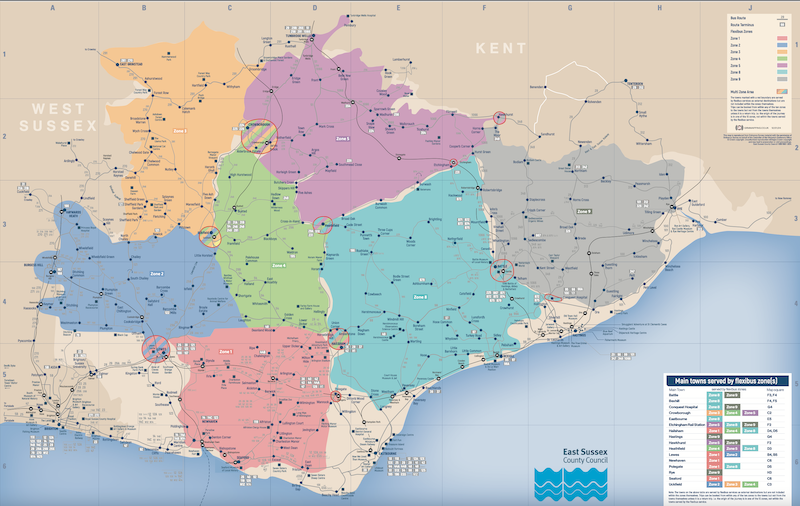
… and West Sussex catching up fast with its fourth and latest Book-a-Bus scheme launching a fortnight ago, we’re not very far from that fantasy prediction.
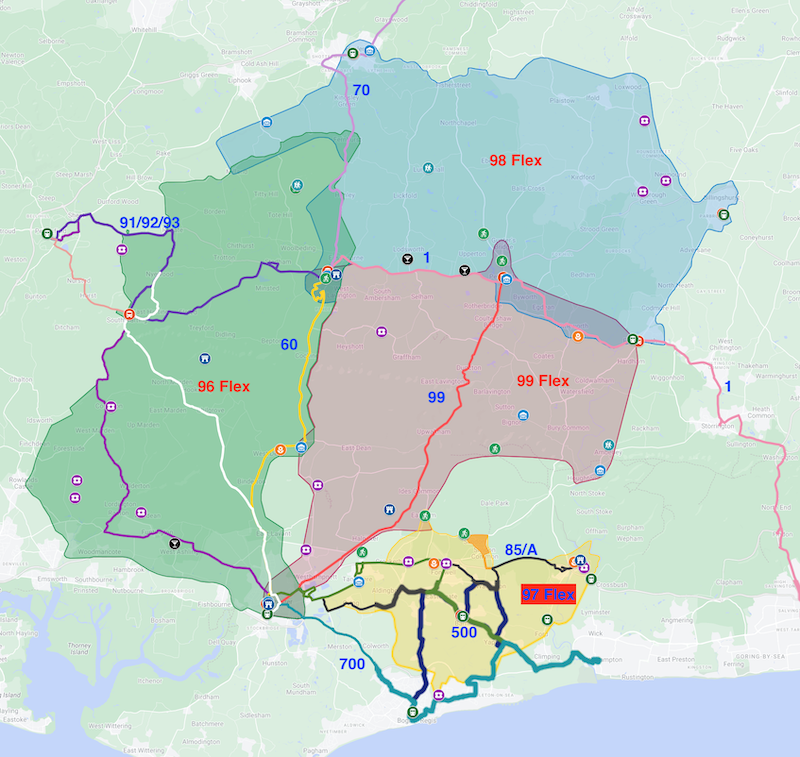
This latest West Sussex addition uses the number 97 Flex (its siblings being 99 Flex, 98 Flex and 96 Flex).
It’s the yellow splurge on the map above, which also shows the other three areas and on which I’ve added route numbers including some of the trunk bus services.
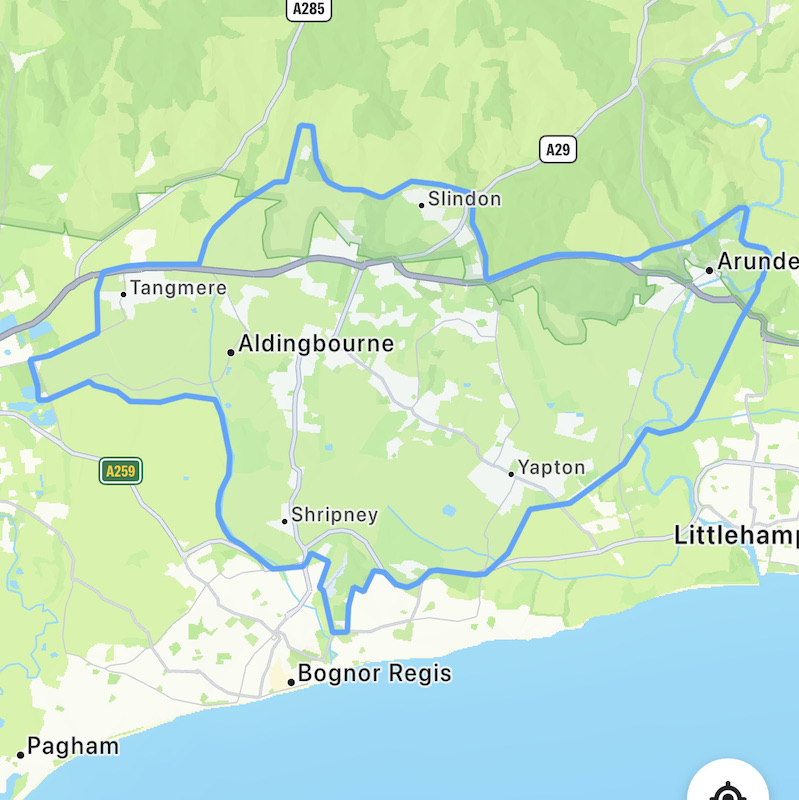
It was introduced on Monday before last (10th June) and is centred on Barnham in an area stretching from just east of Chichester (but not including Chichester) across to Arundel and just north of Bognor Regis (but not including Bognor Regis) up to Eartham.
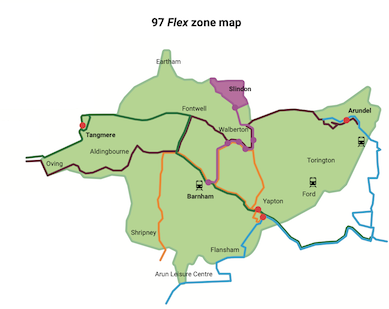
Community Transport Sussex (CT Sussex) operate the service (as they do the 96 Flex and 98 Flex) with one minibus and two driver shifts covering a span from 06:45 until 19:00 on Mondays to Saturdays. However, as is the trend with recent DRT schemes, the weekday peak periods include a fixed timetable linking the villages of Slindon and Walberton with Barnham railway station for connections with commuter trains.

These journeys occupy the bus between 06:45 and 09:30 and between 16:30 and 19:00. Five journeys head to Barnham in the mornings (three originating in Slindon and all five serving Walberton) with three return journeys from Barnham in the afternoons, the last of which needs to be booked.
In between these times (09:30 to 16:30) and all day on Saturdays (07:00 to 19:00) the bus can be booked through an app or a phone line for any journey that can’t be achieved by conventional bus routes or trains within the defined area.
It looks like West Sussex has changed its tech partner. It’s previous three schemes use the Ride Pingo app from the Routing Company but users need to download a different app for the 97 Flex which seems to be from a Canadian company called Spare Labs Inc.
I booked a journey on Thursday evening for a pick up from Arundel railway station to Yapton to travel last Friday in 97 Flex‘s first week of operation.
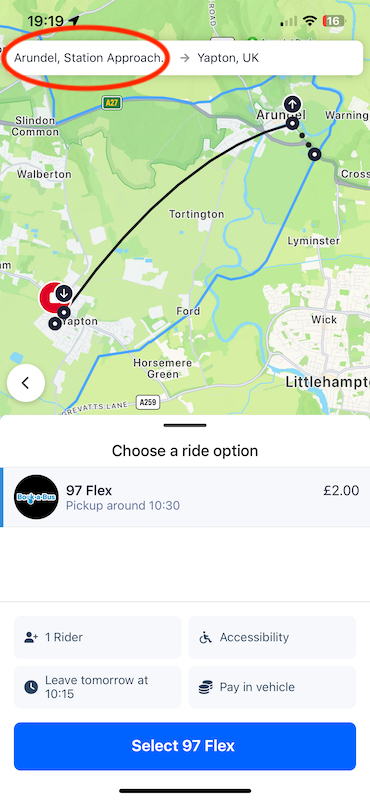
It turned out to be quite an eventful experience for both me and driver Geoff not least as I was only his second passenger by that fifth day, and by an amazing coincidence his third passenger, Steve, joined us during the journey too. But, I’m getting ahead of myself.
As you can see from the screen shot above I tried to book a pick up outside Arundel railway station for 10:15 to connect with my train arrival at 10:02 – knowing from bitter experience elsewhere to allow sufficient time for trains to run late and buses not to wait.
The app gave me a pick up at 10:30 which I was happy to accept – I’d rather wait longer than worry about a tight connection – but noted the pick up given was in Queen Street, Arundel despite asking for the default option in the app of ‘Station Approach Arundel’.

It seems despite advertising that stop and promoting “you can use the 97 Flex service to connect to … onward travel … such as rail stations” this service for some inexplicable reason doesn’t serve Arundel station and users need to take the 12 minute walk into Arundel.
On the train to Arundel a text came through at 09:30 advising my pick up time would be 10:10.

I was concerned this meant I’d be late for the pick up as it’s more than an eight minute walk from the station so I rang the call centre (it’s run by the WeMove company) and spoke to someone who told me he was working remotely, based in central London, whose accent was quite a challenge to understand – especially on a train with a variable mobile phone signal.
Ominously he couldn’t see my booking anywhere on the system which didn’t engender confidence but it turned out he hadn’t been looking on the 97 Flex system even though I made it clear I was travelling from Arundel to Yapton. He had no knowledge of the geographic area.
The app was now showing the pick up amended to 10:10.
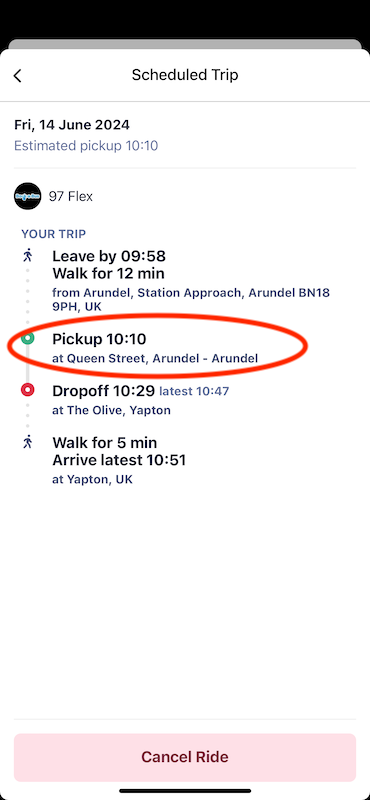
He said he’d contact the driver and ask him to wait a couple of minutes for me.
Next up I arrived in Arundel station and on checking the app it said I had “no scheduled rides” which led me to ring my remote working, hard-to-understand, friend again to ask what was happening and query whether he had cancelled my ride.
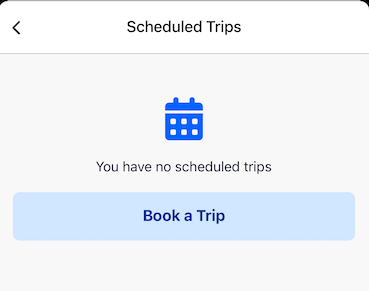
It turned out it was still in the system and after a short while the ride reappeared on the app still showing a 10:10 pick up.
I made it as quickly as I could to Queen Street but was unsure where to wait as whereas normally the app shows the location of the pick up on a map as well as where the bus is, my display seemed to be frozen in time although did show it was “In progress”.
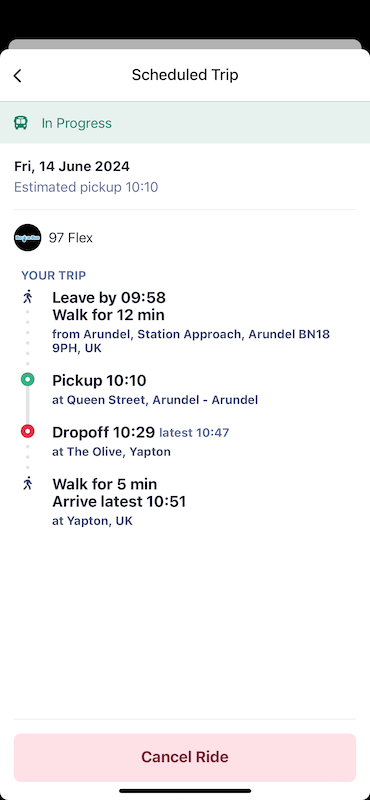
No bus appeared but at 10:15 another text arrived advising “Your Book-a-Bus driver is arriving”.
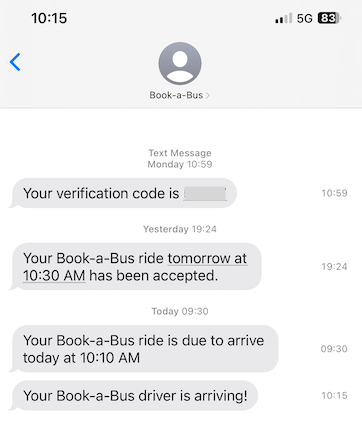
The only trouble was, he wasn’t.
My friend had passed on my request that a manager ring me back to discuss the useless booking system and I got a call from Sam at WeMove who said he’d contact the driver.
The app then showed the estimated pickup time was 10:17.
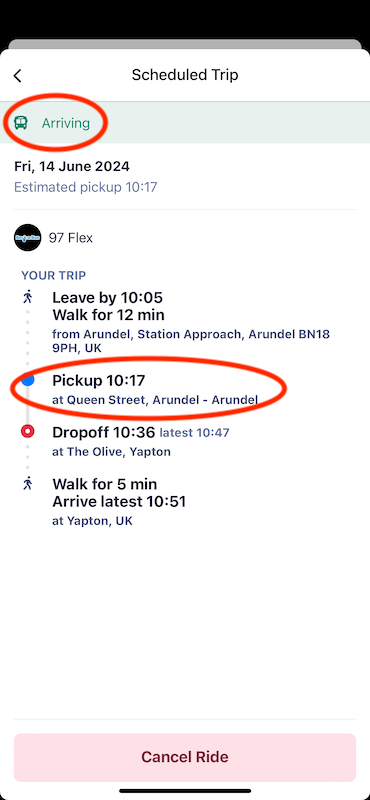
Then I received a call from Geoff, the driver, asking where I was.
I told him at the bus stop in Queen Street looking out for him.
He was at Arundel station.
He wasn’t sure where the pick up point was in Queen Street so I explained how to find me and he finally arrived at 10:32 – 22 minutes after the updated pick up time but only two minutes after the original time!
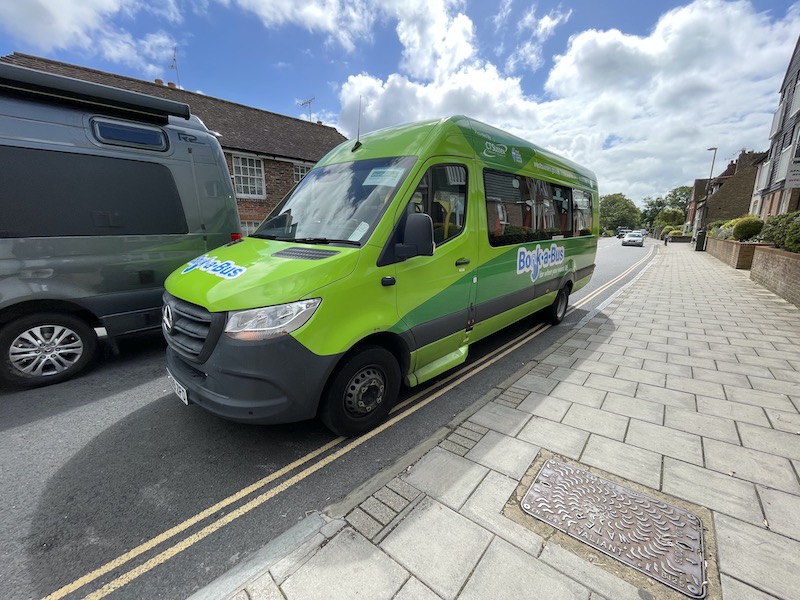
It turned out Dave, his boss at CT Sussex, had rung him and said to go to Arundel station “as an exception” to pick me up … as I was a “DRT Blogger”. I suspect Sam at WeMove had got in touch.
The only problem was no one had told me to wait at the station.
After that fiasco we set off for the estimated 19 minute journey to Yapton via Ford.

But I noticed just as we were nearing the village – about a couple of minutes away at North End – and I expected Geoff to turn left – his SatNav directed him to turn right and we were now heading away from Yapton to Walberton.
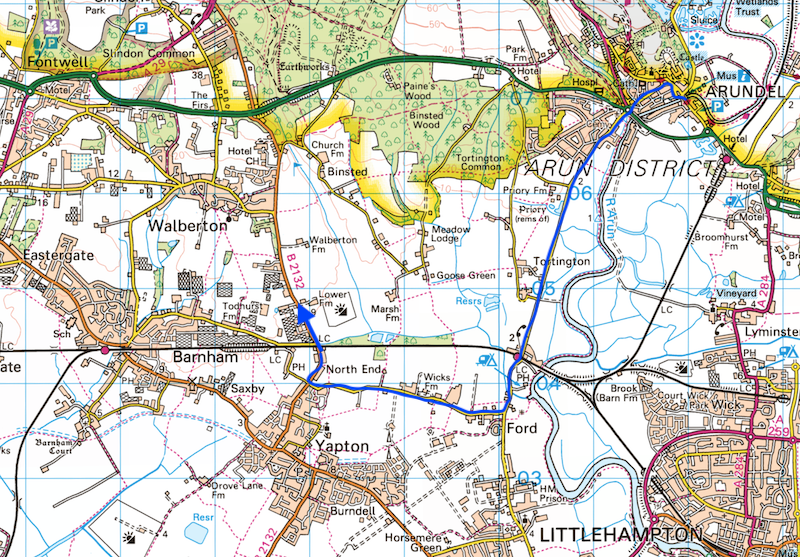
When I pointed this out, Geoff wasn’t sure why this was happening but when we arrived in Walberton, waiting patiently on the pavement, was Steve, a passenger who’d booked a journey to Barnham station, as he showed me on the app display on his phone screen – interestingly my app never did show a map or where the bus was.

Steve wasn’t best pleased at having been kept waiting for half an hour beyond his booked pick up as it meant he’d missed the train he needed to catch.
It was now 10:50 and I wondered whether the software changed my pick up time to 10:10 so that Steve could be picked up around 10:30 by taking a route via the A27 to Walberton, but that didn’t tally with my app still showing an expected arrival time in Yapton at 10:36 (latest 10:47).
We reached Barnham station at 10:56 and dropped Steve off.
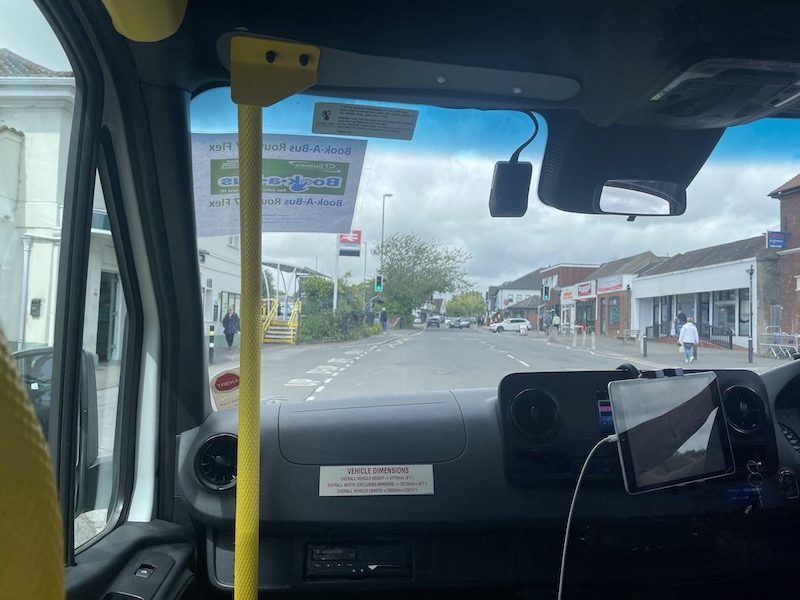
I also decided to abandon my journey there rather than continue to Yapton, it had already taken nearly an hour since I alighted from the train for what should be a 19 minute journey and, like Steve, had lost faith in Book-a-Bus.
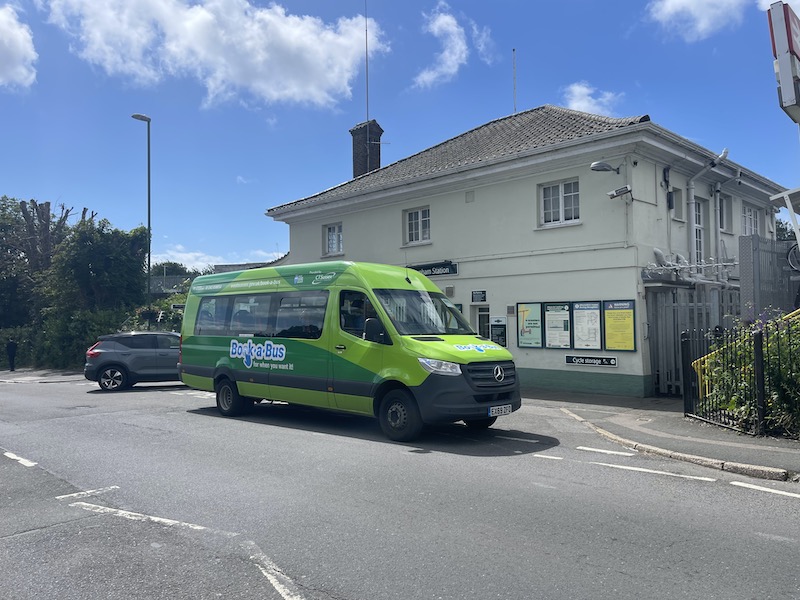
Meanwhile up in Teesside…

… it’s reported in the latest Passenger Transport magazine the Tees-flex scheme which began in 2020 and had its three year trial extended in April 2023 for a further 18 months to October 2024 by Mayor Houchen is costing over £1.2 million per annum with a subsidy per passenger of £14.
Average monthly trips are stated as 7,150 which means across a 12 hour operating day, six days a week with what I believe are 10 minibuses run by Stagecoach on the service, and assuming 26.5 operating days a month …. then 7,150 divided by 26.5 divided by 12 hours divided by 10 vehicles gives 2.25 passengers per bus per hour.
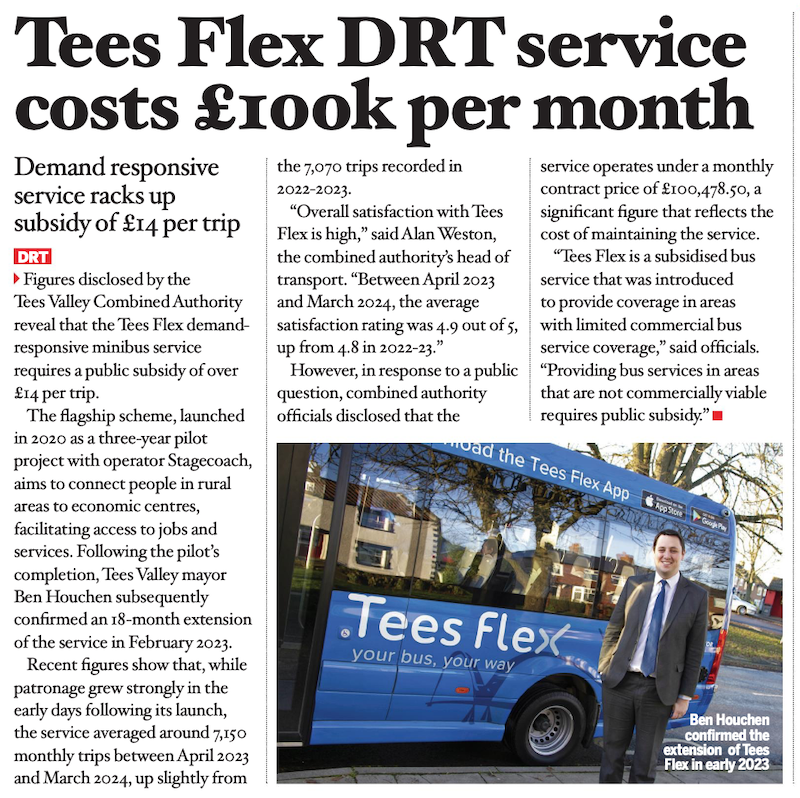
Bizarrely Passenger Transport magazine described it as the “flagship scheme”. Yeah, right.
Roger French
Blogging timetable: 06:00 TThS with Summer Su extras.
Comments on today’s blog are welcome but please keep them relevant to the blog topic, avoid personal insults and add your name (or an identifier). Thank you.


Thanks for the latest tale of woe, Roger. Appreciate your efforts.
BTW, and sorry to be a pedant but it’s Teesside (not Teeside) and the mayor is Ben Houchen. The subsidy figure quoted isn’t a surprise. It’s all emperors new clothes.
KR, BW2
LikeLiked by 1 person
Many thanks for spotting those two howlers. Now corrected.
LikeLiked by 1 person
When are they going to stop flogging these dead horse schemes? Stop making buses like Uber and trains like planes.
Kim R
LikeLike
it’s much the same outside transport where the person on the end of the telephone is remote and has no knowledge of the local area. And they all believe what the computer tells them even when reality is at odds.
LikeLiked by 1 person
It is another DRT service and we know they are very expensive to operate, Get very few passengers and have difficult to use and bug ridden apps and don’t really met passengers needs
DRT though can allow councils to pretend they are providing a bus service. The slight problem is even to provide these few DRT services needs very high levels of subsidy. Most start up with substantial government funding once that runs out they tend to increase the operating area and reduce the operating hours and when that fails axe the service
Up to date data on these services is hard to come by but the failure rate of them appears to be very high well up in the 80% plus region
LikeLike
Good grief – what a shambles, and an appalling waste of money!
LikeLiked by 1 person
With most normal bus service councils would not tolerate that level of subsidy per passenger
There appears to be no set rules for subsidies with each council coming up with its own system Most would look at axing a service if a subsidy went over a few pound per passenger with DRT this does not seem to apply
Passenger numbers are very low typically an average of about 2 an hour and that probably does not take into account the amount of time these buses spend parked up
LikeLike
Surely it does take time parked up into account – that’s why it is 2 pax per hour *on average*
LikeLike
DRT appears to be an excuse for county councils to squander BSIP funding. They all seem to generate an extortionate subsidy per passenger. They are supposed to help the elderly and mobility challenged, amongst others, so what utter nonsense telling someone they can’t be picked up at the railway station but they would have to walk – or get a taxi- to the other end of town to catch the DRT.. This inexcusable nonsense is a wonderful free advert for local taxi firms and the private car industry.
some 2 months ago I tried twice to book one in Hertfordshire. I am STILL waiting for them to tell me if they can do the trip I need. In the end a group of us hired a minibus.
John Crowhurst
LikeLiked by 1 person
| DRT appears to be an excuse for county councils to squander BSIP funding.
I get the feeling that there’s pressure on the county councils from the Department for Transport to use the funding on the amazing “new” invention that is DRT rather than boring, old-fashioned local bus services.
They have form with doing that in the railway industry, providing funding which has to be used on something utterly useless for the location but refusing funding for necessary maintenance work or useful enhancements.
A. Nony Mouse
LikeLike
In Wiltshire I’ve noticed that SEN schools transport has been taken in house, and there is a fleet of white minibuses with Wiltshire Council logos. Wouldn’t it be more cost effective for councils to integrate this with a DRT service outside of school hours. At least that way the vehicles would earn their keep doing the school runs.
Peter Brown
LikeLiked by 1 person
There must be lower cost ways in rural areas of providing school transport then the current system of using taxis at great expense. Most rural counties spend millions on these taxis
There must be a way of better integration of these service so say mini or midi buses could be used and outside of school hours could provide public bus services
LikeLiked by 1 person
This is something that North Yorkshire (County) Council has pursued for several years. There is an unfortunate effect that it has had. It would be ideal were it to have been used for intensely rural bus services – instead NYC has used it to simply replace conventional bus services in most of the small market towns that pepper the county.
Arguably, they have taken the view that for the few passengers that used the local services before 0900 or after 1500, it is most cost effective to simply reduce the service to an off peak service for pensioners.
It doesn’t get away from the fact that DRT is a fundamentally flawed concept but it isn’t the panacea either
BW2
LikeLike
North Yorkshire’s council, like Lincolnshire’s, appears to hold the opinion that “real people” use their cars and that buses are there only for those who are too stupid, ill or dangerous to drive so don’t deserve genuine consideration.
LikeLike
That would resonate with a lady born above a grocers shop in Grantham
LikeLike
You are so right
LikeLike
Depressing waste of money, and to echo a previous comment, merely wasting…..oops! sorry, “spending” DFT money dished out by Politicians who probably have never set foot on a bus in their lives and are clueless about those that do.
But! What delicious irony in the fact that it will almost be certainly a Labour “men of the people” government (if you believe such rubbish, as they all come from the same tree), that will be the ones getting the blame for shutting these schemes down and doubtless facing “protests” from the Multitudes (i.e. Rent-a-Mob).
Terence Uden
LikeLiked by 1 person
Whilst the DFT throws money at LA’s for these schemes they will continue to introduce them, The problem comes when the funding runs out and few people are using them and without government support they will not be able to fund them. All that ignores the fact that DRT is incredibly expensive yet provides a very poor service that few people use because it does not met the need
DRT is just not failing in the UK almost no country in the world is managing to run successful DRT service
LikeLiked by 1 person
I much prefer the flex system operated in many towns in the Netherlands, which uses standard taxis, each able to pick up several passengers with different, local destinations. The system is far less costly than the flex bus system and does not require any special buses or extra drivers.
LikeLike
Good grief! How hard can it be to get a taxi to a pick-up point? Pretty certain my local cab companies had this nailed years ago.
Paul B
LikeLike
Not easy when the app just say it will pick you up in street without saying where in the street
LikeLike
I’m so saddened by this tale and such a waste of resources. It’s rather like a doctor prescribing the wrong medication to address a symptom. And then the medication is of poor quality and not actually fit to address any issue in question.
I fear there are well intentioned individuals seeking to ensure rural communities are not isolated but lack local knowledge with a ragbag of solutions. It can all be sorted with better training and a clear understanding of precise needs of each community Work closely with Parish Councils for example.
By the way I like the Dutch example of using shared taxis and fixed route buses. But application depends on first understanding need.
Keep up your excellent work Roger!
LikeLike
The one benefit of DRT is IT SHOULD provide a detailed log of when and where people want to travel to.
Having acquired this data it can then look at setting up a fixed or semi fixed route to meet the actual travel need
LikeLike
Look up Swiss Publicar to see how a nationwide system is described in detail, by areas, with decent maps, . even in English. The fare is the standard Postbus fare plus 5 francs surcharge for each journey, for which you can get a discount by buying, say, 10 at a time. I have often seen these in Switzerland, though fewer in recent years, often to be seen at stations.. They only operate in a few areas now, so maybe have lost custom..
malcolm chase, Buses Worldwide
LikeLike
Everyone outside Switzerland swoons over Swiss public transport, but whenever I’ve travelled around the country I’ve noticed two things: frequencies are pretty low and there are lots of cars on the roads.
I suspect those two things may be linked.
A. Nony Mouse
LikeLike
But low frequency is much less of a problem when everything connects so well. It’s one hourly bus missing one hourly connecting bus / train by 5 mins (as is not uncommon in the UK) that is the problem!
LikeLike
DRT = chocolate teapot.
John
LikeLike
If ONLY the millions spent on these totally DRT services had instead been allocated to semi-flexible ‘many-to-one’ or ‘divert-on-demand’ services with fixed times at one or both ends (á la Petworth 99, Wiltshire Wigglybus,…) think what a brilliant rural bus provision we could have had by now…..
Clearly there now needs to be a robust comparison study based on passengers-per-hour and subsidy-per-passenger between traditional rural service, semi-flexible service and fully flexible service.
LikeLike
There is a conundrum in trying to merge the use of SEN (special educational needs) transport with mainstream DRT services . . .
SEN vehicles need to be equipped with wheelchair lifts and fixings, and often only convey 2-3 passengers at a time; logically, these services are “many to one” operations, and often are required in the middle of the day as well (transport to swimming pools, or to other centres for example). Many SEN passengers are actually accommodated in taxis or taxibuses. . . there are some passengers that can’t be mixed together with other passengers.
DRT buses need seats and a “split-level” arrangement (wheelchairs on the lower level, seats on a raised area, as per Mellor minibuses, for example).
Whilst it wouldn’t be impossible to create a “universal” vehicle to meet both needs, I would submit that having to reseat or deseat buses twice a day would make life very difficult.
It would be interesting for a National Audit Office investigation into DRT to be commissioned . . . but it’s all too late now . . .
As a side note . . . many of the Devon “FareCar” services seem to have been withdrawn in the latest Devon CC bus timetables . . . in addition, these books don’t seem to show rail timetables any more.
LikeLike
Very little SEN transport needs wheelchair accessible vehicles
LikeLike
When l was a kid the local ESN pupils were simply conveyed in a full size standard coach.
LikeLike
James – sorry that in my comments I addressed you as Roger – it was meant to say “Roger over and out” but predictive text thinks it knows better. The lesson is to check and check again. Seriously you are doing a great job in highlighting the good, bad and “could do better”.
Tony Francis
LikeLiked by 1 person
AI in action! The computer knows better with the same logic being applied to these useless DRT schemes.
LikeLike
I always think these DRT schemes are dreamed up by the sales department of a certain bus/van manufacturer and a conversion specialist for the above, non seem to work, as the office based people have no idea about geography of where they operate.
Thats the way i see it from reading your posts, whats needed is proper timetables , running at times all day every day to encourage people to use them eg just like big buses do, but using small buses, see comment above.
LikeLike
Nothing to do with manufacturers and much more to do with pedlars of software!
BW2
LikeLike
But the point is you can’t have small buses running all day every day, because that’s nowhere near affordable. Hence why DRT, covering large areas with minimal resource, is superficially attractive.
LikeLike
There should be a way to make this work and make it more appealing in situations where the alternative is a highly irregular fixed route and times with very limited appeal, but clearly the funds are not being well used and the booking tech and operation on the road are just not coming together in anything like a practical and reliable manner. Perhaps with a new incoming Government a new minister might be persuaded to take a fresh look and use public funds in a better way.
LikeLike
Why can’t we just invest in conventional bus routes. And if you use buses regularly, then as a perk you can have a subsidy on occasional taxi use where the buses don’t go. That subsidy would be instead of DRTs. A simple, intuitive way that builds on local knowledge that taxi firms have… CH, Oxford
LikeLike
Roger,
Next time you are in Scotland we really have to catch up for a chat
Much to develop – especially as many bus operators already have a taxi app plus the Ticketer machines have a large screen display which (10 years ago) i was told that this could connect with bus tracking & other systems, to display a manifest for the next stop
With the village taxi service signed up to deliver fixed fare multi passenger collections to the bus stop, on a main road and (faster) service reducing bus operating costs by getting the passenger to the bus at a lower cost than getting the bus to the passenger
I was using Western Scottish 52 Ayr-Dalmellington, and working in Patna. I could see the bus arriving, pack up and cycle to the North end of the village and catch that same bus. Some rough calculation suggested that the SVR and journey times could be cut by 50% by using a local taxi operator to deliver PUDO for passengers over wide area with both the taxi driver & bus driver kept aware of any delays, and passengers checked in against the manifest. This is already happening with Ember who maximise the use of their 100% electric coaches by operating 24/7 between 5 citi8es in Central Scotland, with the drive responding (with 10min advance notice) to make calls at locations barely ½Km from the M9 or M90. I’ve seen this delivered when the #Flixbus from Dundee was delayed, and the travel savvy passenger booked to join the Ember service at Cumbernauld just as this service departed from Glasgow
Given the huge potential to offer fast coach services (Best time for Ember Dundee to Edinburgh – 50 minutes but the offer from those providing the coach stops is risible – Harthill with over 20 coaches per hour has exposed stops (with no shelters just below the summit at Tams Loup) Stirling has the waiting areas locked up with not even a canopy outside, only Broxden has a moderately decent offer by default as you can walk over to the convenience store at the 24 hour filling station
We seriously need to kick a few silos here – perhaps a review of those coach interchanges, ranging from J14 Coachways on M1 to a miserable roadside wait at so many other places
I also want to highlight the ‘bus shelters’with draught beer and a warming fire such as tha in Tarbolton, where the local arrangement is for drivers to sound the horn as they drive into the village and passengers drink up to step outside as the bus returns
Of course you might remember the hilarity from a meeting to discuss bike racks on buses and Paul Williams suggested that we used a large motor car with less than 8 seats which just happened to be de-rated to a Class 4 vehicle that just happened to be 12 metres long & 2.5 metres wide, and could be modified with a lot less paperwork to test the details
I continue to hope that the old SMT policy of carrying cycles on all rural services, and expanding the catchment area by a factor of 15. Its taking a long time 20 years to get bike spaces reserveable with Scottish Citylink , and I started this with Mike Lambden of National Express in 1996!
LikeLike
Apologies Roger
Its H in Glasgow itching to work with bus operators to deliver total mobility as a flexible choice
Only £2.25 for Glasgow Zonecard with unlimited bus, subway & rail for the main Glasgow area
LikeLike
£2.25? We can dream! The new Zonecard is £8.40 for central Glasgow or £12.80 for the whole city – neither of which strike me as particularly good value. It’s the first time that there’s been a proper bus/train/underground combined ticket though, so I suppose it’s a start.
LikeLike
I tried using the Surrey Connect service last week. I needed to get to East Surrey Hospital, and the fixed bus routes are mostly north/south whereas I wanted to go west, so DRT would have been ideal. Except that the DRT does not serve the hospital. Hopeless!
MotCO
LikeLike
Swiss frequencies low? Thats not my impression – many routes are far more frequent than in my earlier old Swiss Kursbuchs of the 1960s and 1970s. Many Swiss do not have or use cars, unlike here, as they can get everywhere by public transport. Taxis are very rare
malcolm Chase
LikeLike
According to the Wikipedia, Switzerland has a very slightly higher level of car ownership than the UK – one place above UK in this table:-
https://en.wikipedia.org/wiki/List_of_countries_and_territories_by_motor_vehicles_per_capita
RC169
LikeLike
Car ownership doesn’t necessarily translate to car usage, especially if there is a good alternative. Cars are so convenient for most people, almost addictive, but that doesn’t mean we just give up and don’t provide the best public transport we can.
Also climate change mitigations mean that car use MUST come down, so not investing in alternatives isn’t an option. On a financial point, cars ownership is a massive annual outlay. If we had proper cycling infrastructure in towns many households could get rid of the second car, and save a lot of money for other things.
Anyway, here is some more Swiss stuff:
https://medium.com/from-the-red-line/the-swiss-standard-7d0ba9865cb1
Peter Brown
LikeLike
Thanks for this. The pfaff generated by not serving the station is particularly bad, it’s a hike into town. (Also, did you mean Queen’s Lane rather than Queen Street? The latter doesn’t appear to exist – and the former is in part a cul-de-sac, the rest being narrow and not particularly safe in which ot wait for a bus…)
Mark
LikeLike
It says Queen Street on the screenshot. If the road doesn’t exist, then that’s an even greater indictment of poor software.
JD
LikeLike
There is certainly a Queen Street in Arundel, which is the one shown on the photo of the mobile phone display. So I am not sure which Queen Street – allegedly – does not exist? But there is also a cul-de-sac named Queen’s Lane, as referred to by Mark above, and that is in Arundel:-
https://www.openstreetmap.org/relation/2960986#map=17/50.85347/-0.55424
Nigel Frampton
LikeLike
On the one hand you have DRT run as standalone services with high subsidies (and poor experience/usage), and on the other you have experiments with subsidising Uber to accept DRT passengers at a discount provided by a local government body (with some restrictions) at a high subsidy cost (but with mostly happy passengers getting, in effect, a premium service at a discount).
But the optics don’t look good for the latter, even though there is clearly a middle ground where you could govern usage of such a service (sharing, trips per rolling month, time of day, etc.) to constrain the cost.
Either we have to accept as a society that either
* your choice of where you live will affect your lifestyle (i.e. if you can’t/won’t drive, live in a town that has all the facilities you need readily to have, and if that means you need to move more frequently and break existing social links, so be it),
or we have to accept that equitable public transport for all has a cost, and it’s impossible to reduce that cost below a certain amount for an acceptable service level, and decide what is the best blend of service we can get for that money (scheduled, paratransit, schools transport, volunteer “hospital” car service supported by some government money, postbuses with a operating obligation as part of postal USO, etc.)
MilesT
LikeLike